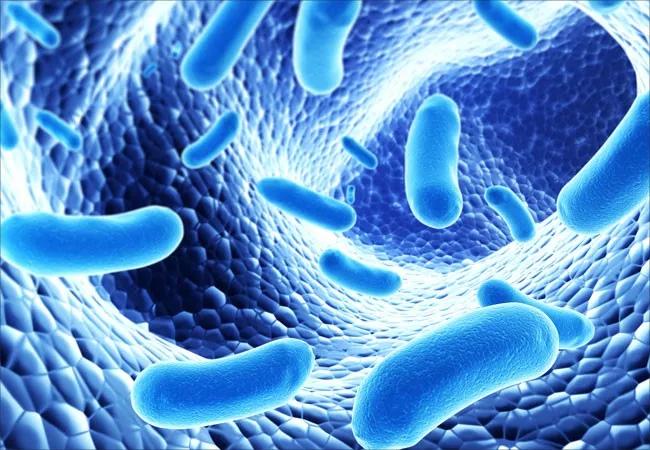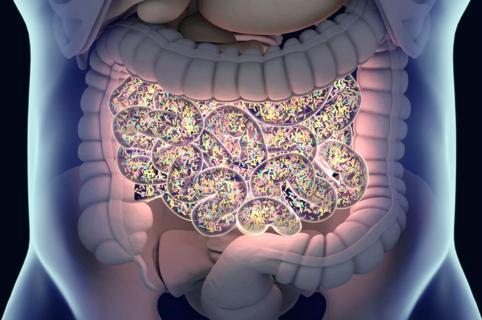Mouse study shows most potent therapeutic ‘drugging’ of microbiome to date

New research published in Nature Medicine provides support for a novel approach to reduce platelet hyperresponsiveness and thrombosis potential without increased bleeding risk by nonlethally targeting the gut microbial pathway that produces the metabolite TMAO.
Advertisement
Cleveland Clinic is a non-profit academic medical center. Advertising on our site helps support our mission. We do not endorse non-Cleveland Clinic products or services. Policy
The targeting was done in a mouse model of arterial injury with a new drug class developed by Cleveland Clinic researchers known as mechanism-based inhibitors. These agents potently interrupt the gut microbial pathway that produces TMAO (trimethylamine-N-oxide), which has been associated with increased risk of cardiometabolic disease.
“To our knowledge, outside of antibiotics, which cannot be used chronically without generating resistance, this is the most potent therapy to date for ‘drugging’ the microbiome to alter a disease process,” says Stanley Hazen, MD, PhD, who led the research, which was conducted at Cleveland Clinic. “We showed that gut bacteria were altered but not killed by these therapies, and there were no observable toxic side effects. This approach could potentially be used to target other gut microbial pathways while minimizing systemic drug exposure and antibiotic resistance.”
The work is the latest installment in Dr. Hazen’s long series of investigations around the role of TMAO in cardiometabolic disease. In several landmark studies, his team of Cleveland Clinic researchers was the first to demonstrate that TMAO is produced when gut bacteria digest choline, lecithin and carnitine — nutrients that are abundant in animal products such as red meat and liver. Choline is likewise abundant in egg yolk and high-fat dairy products.
Elevated blood levels of TMAO are strong predictors of risk for myocardial infarction, stroke and death, according to earlier research by Dr. Hazen’s team that was later replicated around the world. The Hazen group subsequently showed that TMAO promotes platelet reactivity and thrombosis potential.
Advertisement
The new study builds on a recent investigation by Dr. Hazen’s team of the naturally occurring TMA lyase inhibitor 3,3-dimethyl-1-butanol (DMB), which is found in extra virgin olive oil. That study showed that DMB significantly lowered plasma TMAO levels in atherosclerosis-prone ApoE–/– mice while also attenuating atherosclerotic lesion development.
“Although atherosclerotic plaques are a defining feature of coronary artery disease, it is enhanced platelet reactivity and acute thrombotic occlusion of vessels that are the proximate cause of major cardiovascular events,” says Dr. Hazen. “Antiplatelet agents have become a cornerstone of therapy for cardiovascular event reduction, but their more widespread use has been limited by an elevated risk of bleeding. That’s why we focused this study of second-generation TMA lyase inhibitors on attenuating thrombosis while also limiting systemic exposure in the host through mechanism-based nonlethal inhibition of the gut microbial TMAO pathway.”
The new compounds studied in the current investigation — known as halomethylcholines — are choline analogues that effectively trick bacterial cells into taking them up as nutrients like choline, but with a twist. Once transported into the microbe, these compounds act like a Trojan horse and get converted into potent inhibitors of TMAO production by irreversibly inactivating a gut microbial enzyme known as CutC/D.
Dr. Hazen’s team found that a single oral dose of these mechanism-based inhibitors significantly reduced plasma TMAO levels in the mouse model for up to three days and reversed both enhanced platelet responsiveness and heightened thrombus formation following arterial injury. “This new class of drug was approximately 10,000-fold more potent than DMB,” observes Dr. Hazen.
Advertisement
Once taken, the inhibitors were minimally absorbed into the body but instead remained in the gut, where they selectively accumulated in the microbes, targeting the TMAO microbial pathway at a concentration over a million times higher than needed for a therapeutic effect. Because they were designed not to kill bacterial cells, these mechanism-based inhibitors are not expected to induce antibiotic resistance.
The compounds reduced hyperresponsive platelet function to normal, inhibiting excessive clot formation, but without taking platelet function below normal. “This suggests that bleeding should not be an adverse complication of this mechanism-based mode of inhibition, in contrast to all other antiplatelet therapies,” notes Dr. Hazen.
“This research has identified a new potential target for the treatment of individuals at risk for thrombotic complications and cardiovascular disease,” Dr. Hazen concludes. “We look forward to advancing this novel therapeutic strategy into humans.”
Dr. Hazen acknowledges the contributions of the co-first authors on the paper: Adam Roberts, PhD; Jennifer Buffa, MS; and Xiaodong Gu, PhD, all of the Department of Cellular and Molecular Medicine in Cleveland Clinic’s Lerner Research Institute. Dr. Hazen chairs that department and directs Cleveland Clinic’s Center for Microbiome and Human Health in addition to serving as co-Section Head of Preventive Cardiology and Cardiac Rehabilitation.
The research reported here was supported by grants from the National Institutes of Health and the Office of Dietary Supplements.
Advertisement
Advertisement

First full characterization of kidney microbiome unlocks potential to prevent kidney stones

Researchers identify potential path to retaining chemo sensitivity

Large-scale joint study links elevated TMAO blood levels and chronic kidney disease risk over time

Investigators are developing a deep learning model to predict health outcomes in ICUs.

Preclinical work promises large-scale data with minimal bias to inform development of clinical tests

Cleveland Clinic researchers pursue answers on basic science and clinical fronts

Study suggests sex-specific pathways show potential for sex-specific therapeutic approaches

Cleveland Clinic launches Quantum Innovation Catalyzer Program to help start-up companies access advanced research technology